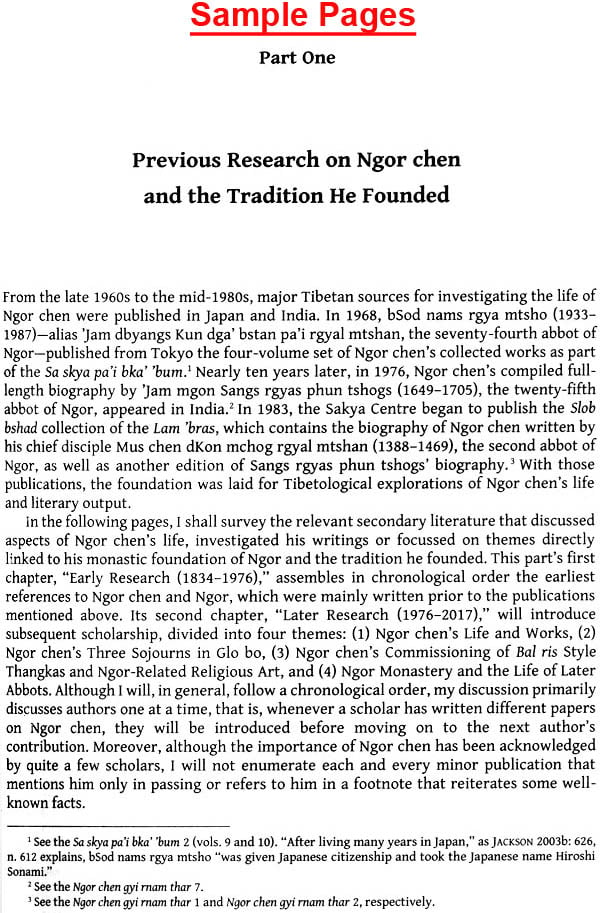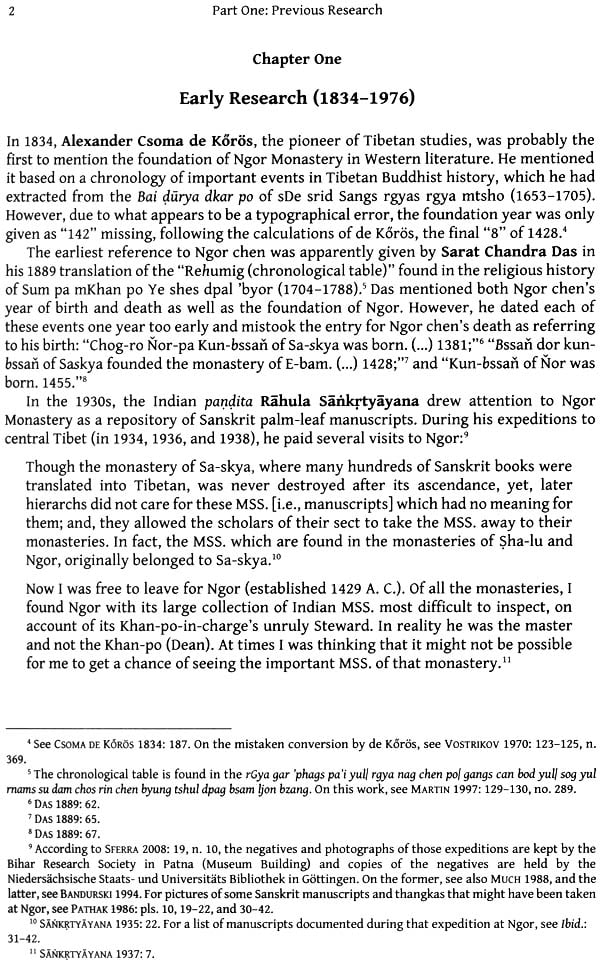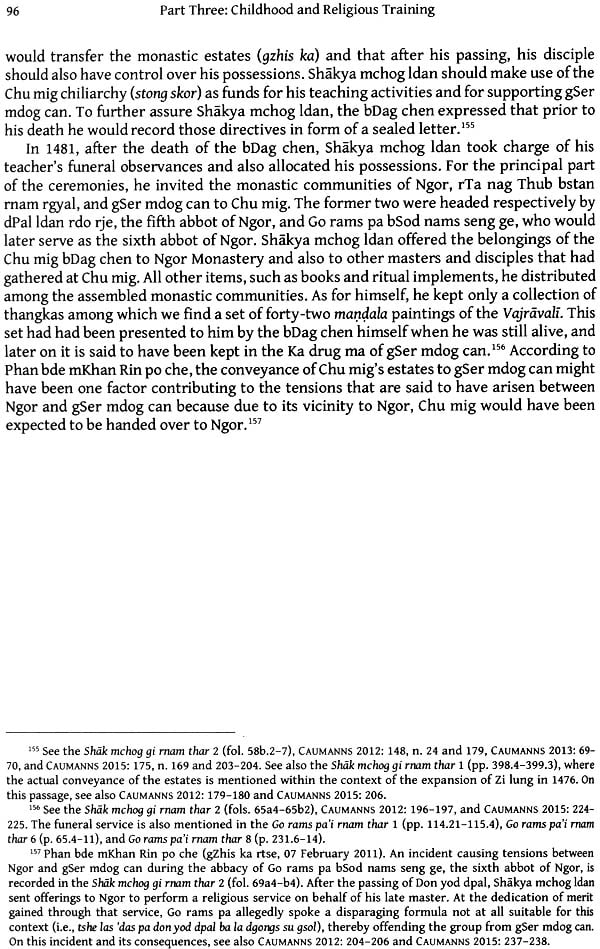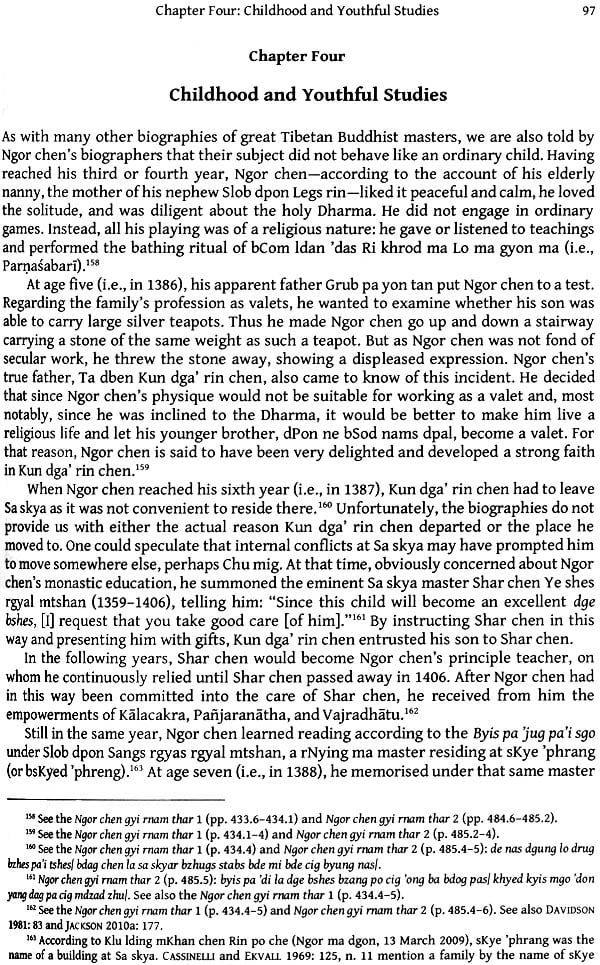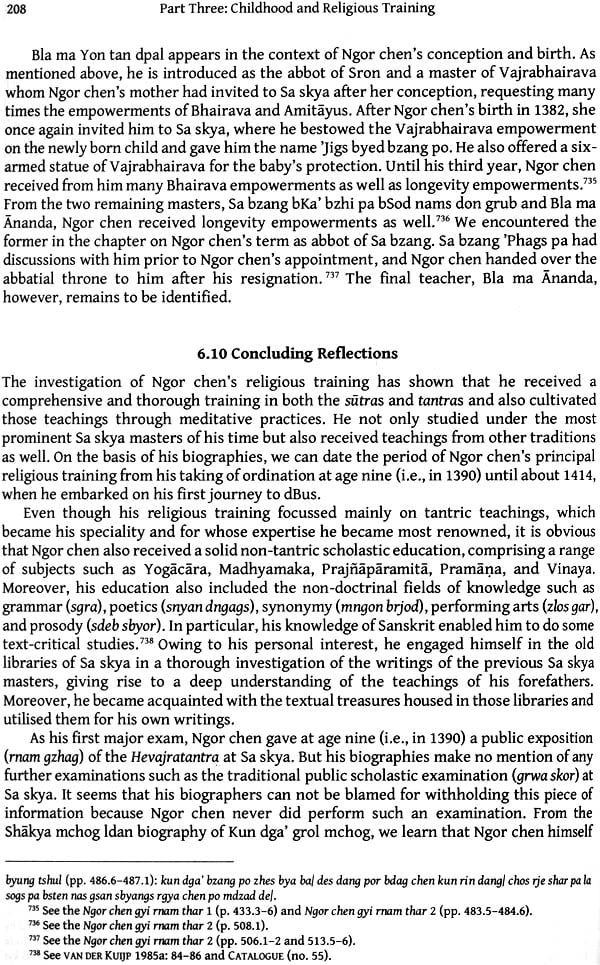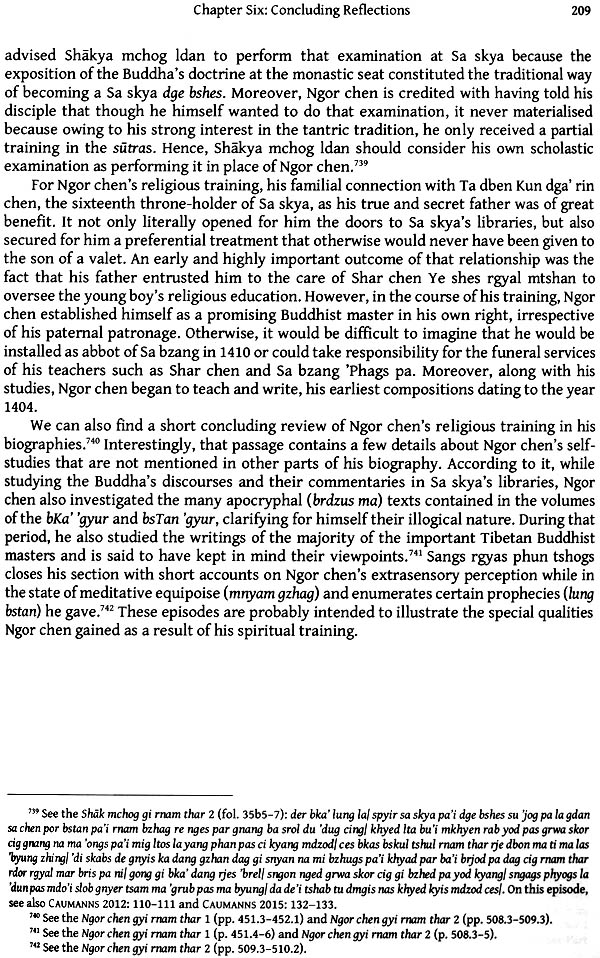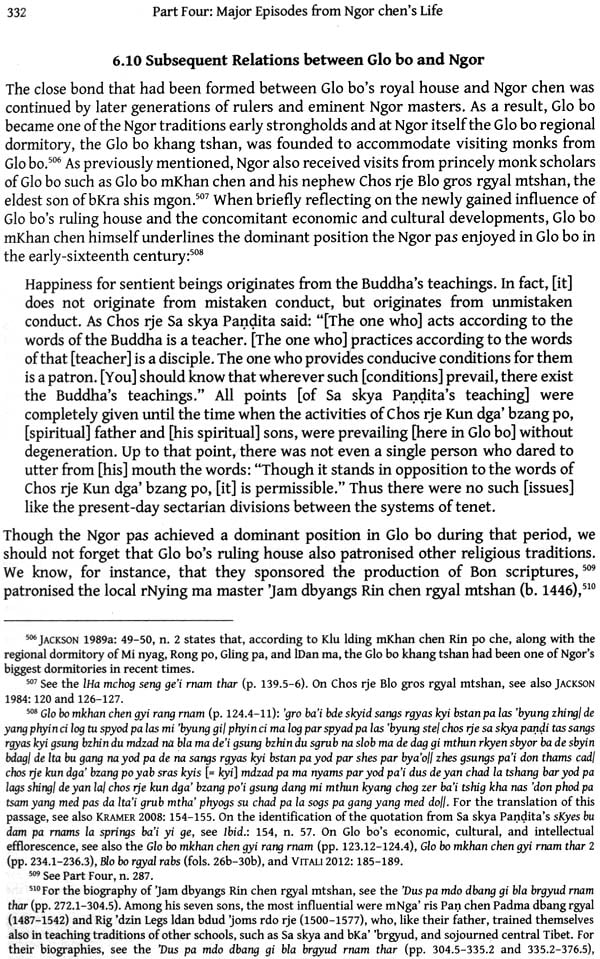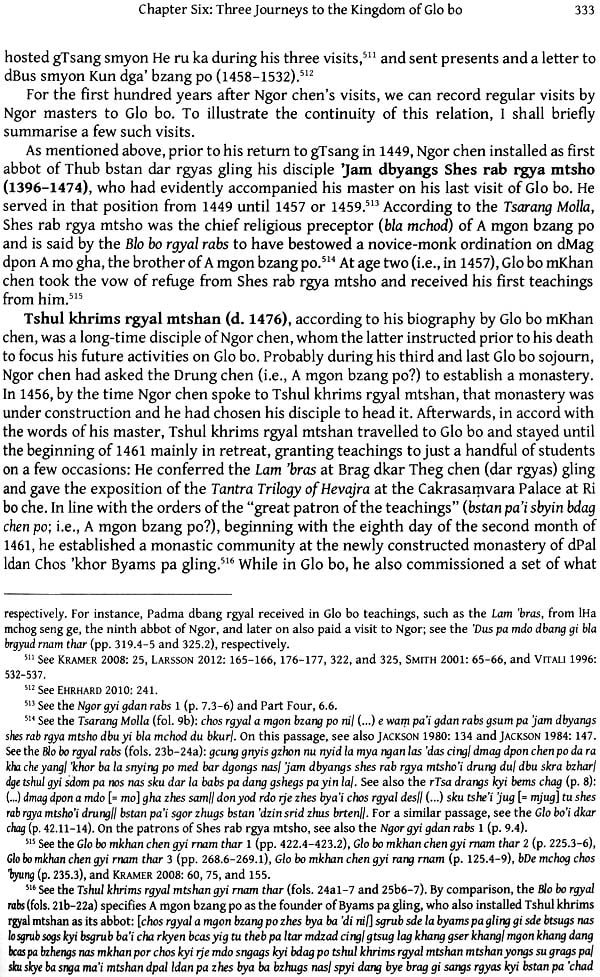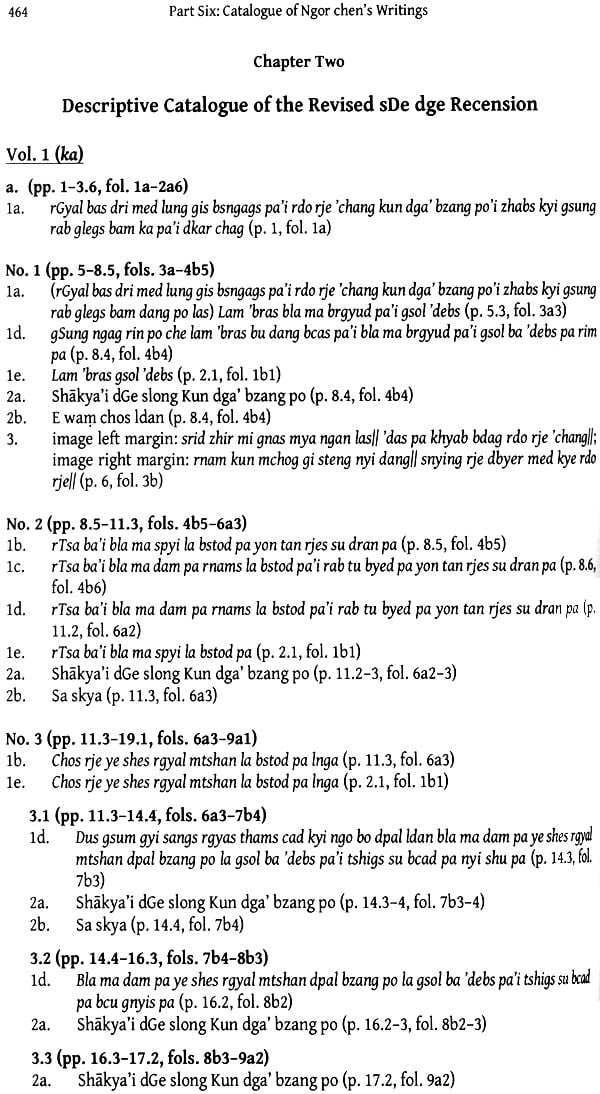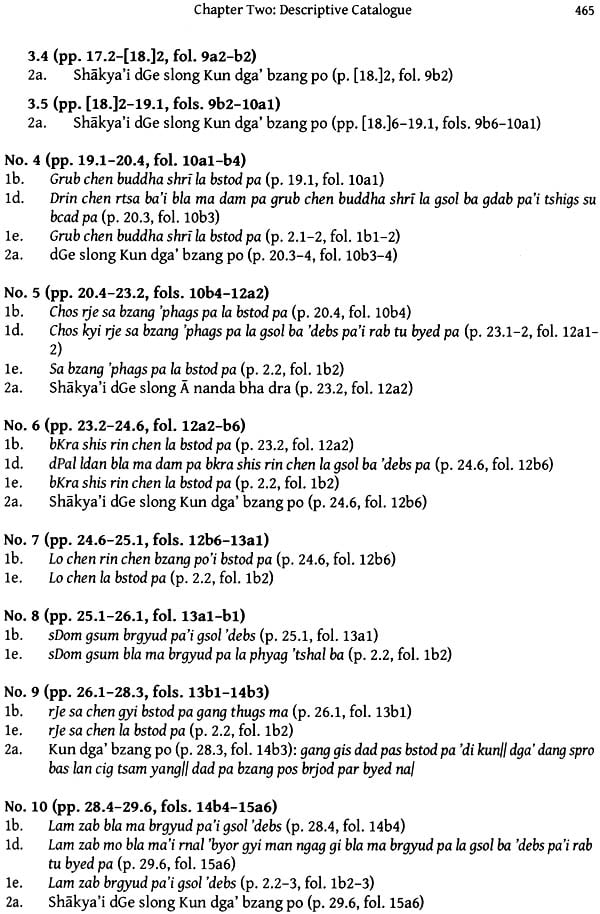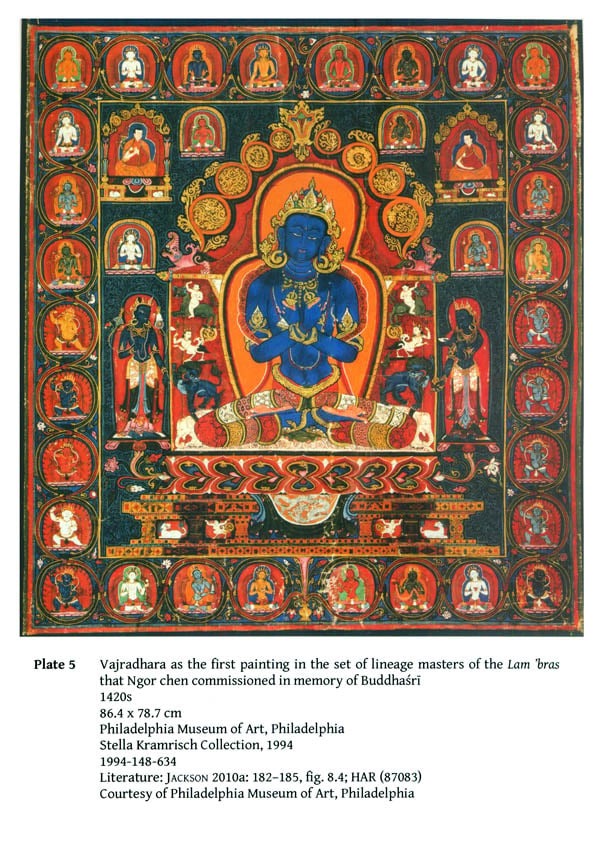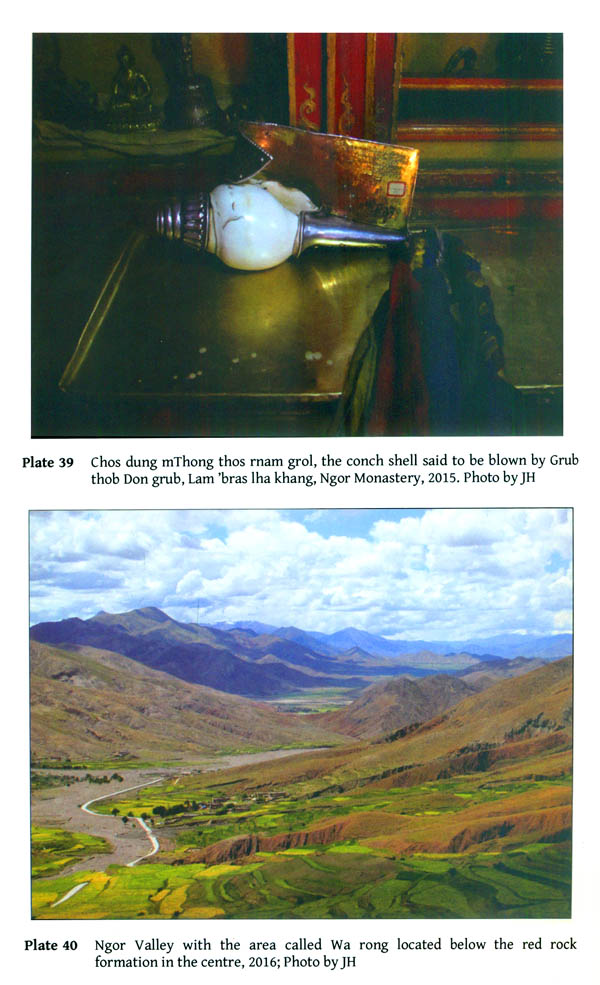
Vajradhara in Human Form: The Life and Times of Ngor Chen Kun Dga' Bzang Po
Book Specification
| Item Code: | NAN297 |
| Author: | Jorg Heimbel |
| Publisher: | Lumbini International Research Institute, Nepal |
| Language: | English |
| Edition: | 2017 |
| ISBN: | 9789937028493 |
| Pages: | 702 (48 Color Illustrations) |
| Cover: | Paperback |
| Other Details | 9.5 inch X 6.5 inch |
| Weight | 1.10 kg |
Book Description
In the autumn of 2007, I travelled with a friend and colleague through the Tibet Autonomous Region (TAR), visiting monasteries in and around lHa sa, gzhis ka rtse, and rGyal rtse. One day, we also paid a visit to the monastery of dPal Ngor E warn chos ldan, located to the southwest of gzhts ka rtse in the upper reaches of the colourful Ngor valley. Walking through the restored monastic complex, I had no idea that just one year later I would embark on a scholarly journey into the history of Ngor Monastery, investigate the life of its founder or return a few years later to discuss details of his life with its incumbent abbot. Against this background, it seems that during my first visit some auspicious connection (rten 'breI) may have been formed that led me to delve into the history of the monastery and its tradition-a connection that was deepened further over the years by the openness and hospitality of the many Ngor masters and monks I was fortunate to meet and work with.
Ngor Monastery was founded in 1429 by one of the most outstanding and influential Sa skya masters of the fifteenth century, Ngor chen Kun dga' bzang po (1382-1456), who is honoured by his own tradition as one of its "Six Ornaments that Beautify the Snow Land [Tibet]."l Like Tsong kha pa Blo bzang grags pa (1357-1419), Ngor chen can be considered a reformer who tried to renew his own Sa skya school from within. He made efforts to cleanse the Sa skya teachings from elements he considered to be mistaken, aiming to return to the religious roots of his tradition by transmitting what he perceived to be the pure and untainted teachings of the early great Sa skya founders, such as Sa chen Kun dga' snying po (1092-1158) and his sons, Slob dpon bSod nams rtse mo (1142- 1182) and r]e btsun Grags pa rgyal mtshan (1147-1216). Withdrawing from the worldly distractions of the bustling town of Sa skya as well as from sectarian conflicts, Ngor chen left his traditional alma mater of Sa skya Monastery and set up his new monastic seat in the remote Ngor valley, located about 30 km southwest of bSam grub rtse (present-day gZhis ka rtse), where, based on the observance of a strict monastic discipline, he hoped to go back to traditional Sa skya teaching and practice in a more supportive environment. Immediately, Ngor became a new centre for tantric training within Sa skya pa monastic circles. Ngor chen, as the leading tantric expert, trained a whole new generation of young students, producing some of Sa skya pa's brightest minds, such as the illustrious and controversial figures gSer mdog Pal). chen Shakya mchog ldan (1428-1507) and Go rams pa bSod nams seng ge (1429-1489). In doing so, Ngor chen became the founding father of the Ngor tradition (ngor lugs), which quickly developed into the most prominent subdivision of the Sa skya school. At a crucial point in the history of the Sa skya pa, who had lost their political power in the mid-fourteenth century with the collapse of the Yuan dynasty (1271-1368), Ngor chen was one of a few highly influential figures whose activities caused Sa skya's influence on the religious sphere not only continue to flourish but also to strengthen. Furthermore, through his religious activities, he was able to establish new bonds on the political stage with such powerful rulers as the kings of Mustang (Glo bo).
Modern research has acknowledged the great influence Ngor chen exercised on Tibetan religious life, as is immediately evident from the abundance of references to his person that we encounter in the secondary literature. Given his importance, it is striking that Tibetological scholarship mainly restricted itself to studying certain aspects of his life within other contexts, but did not devote a full-length study to his life in its own right, a prerequisite for better understanding his manifold activities within the interconnected religious, socio-cultural, and political contexts of fifteenth-century Tibet. This period has been described as "a phase in the religious and cultural history of Tibet marked by an enormous productivity in shaping the spiritual traditions that had been received during the first and second spread of the Buddhist doctrine," or likewise as "a period generally characterized by widespread scholastic activity and intellectual efflorescence.?" During that constructive period, Ngor chen was one of a number of important figures that appeared on the religious scene pursuing their individual agendas by various means, such as reforming and further reshaping their own traditions, establishing new monastic institutions, and forming important alliances and networks of support with wealthy and powerful patrons. Ngor chen also witnessed the emergence and swift rise of the influential dGa' ldan tradition, which quickly changed the religious climate, leading to sectarian conflicts and polemical exchanges with far-reaching consequences that would also effect Ngor chen.
Against this background, the present study aims at positioning Ngor chen within the multi-layered and interlinked religious, socio-cultural, and historical contexts and developments of fifteenth-century Tibet, thereby clarifying his role and formative impact on the: further development of Tibetan Buddhism, in general, and of the Sa skya school, in particular. The investigation of the life of Ngor chen serves as a case study to exemplify the various developments that took place during that important period of Tibet's history. It aims to show how Ngor chen's religious career was not only influenced by these developments, but also how he actively took part in shaping the new religious landscape of fifteenth-century Tibet. By outlining Ngor chen's religious training and career, this study hopes to make two further contributions: firstly, to fill gaps in our knowledge of the Sa skya pa's religious history during the fourteenth and fifteenth centuries, and secondly, to trace the genesis and further development of the Ngor tradition as it was established by Ngor chen and his successors on the abbatial throne of Ngor.
The present study was undertaken by a combination of philological-historical and ethnological methods, including expert interviews (conducted in Tibetan). Major parts originate from a careful and close reading of a wide range of Tibetan textual sources central to the life and times of Ngor chen and his tradition. This corpus of sources comprises (1) the extant biographies (mam thar) of Ngor chen and his teachers, disciples, and important contemporaries, (2) Ngor chen's own writings, (3) autobiographies (rangrnam) and biographies of successive Ngor abbots and influential Ngor masters, as well as the successive abbatial histories (gdan rabs) of Ngor Monastery, and (4) a variety of religious histories (chos 'byung), genealogies (gdung rabs), religious chronologies (bstan rtsis), and other sources dealing with the religious, political, and doctrinal developments important to the life of Ngor chen and the history of his tradition. In the field, these sources were read in whole or in part with Tibetan scholars and difficult passages contained therein were discussed in detail. In addition, interviews on Ngor chen, the history of Ngor and its tradition were conducted with leading lamas of the Ngor tradition, such as Klu lding mKhan chen Rin po che 'Jam dbyangs bsTan pa'i nyi ma (b. 1931), the seventy-fifth abbot of Ngor (tenure: 1954-1957). Two other important research steps that greatly enhanced my understanding were visiting such monasteries as Ngor, Chu mig, and Sa skya, and discussing my research project with Phan bde mKhan Rin po che 'Jam dbyangs Thub bstan snying po, the present abbot of Ngor Monastery in the Tibet Autonomous Region (TAR). This study also benefitted enormously from the greater accessibility of many important textual sources that surfaced during my research, owing to the efforts of the late mKhan chen A pad Rin po che Yon tan bzang po (1927-2010) and the dPal brtsegs bod yig dpe rnying zhib Jug khang, researchers and publishers of rare books.
In the present study, I have deliberately decided against preparing a translation of one of two extant full-length biographies of Ngor chen. Though this would have revealed my unsatisfactory translation skills, that is not the reason I have chosen not to include such a translation; rather I found it more important to thoroughly analyse the aforementioned corpus of texts than to restrict myself to just one of Ngor chen's biographies. That put me in a much better position to embed his life in the eventful developments of fifteenth-century Tibet and to assess the impact of his manifold activities. However, to convey a better impression of how Ngor chen is portrayed by his biographers and other Tibetan authors, I found it equally important to provide translations of significant episodes from his biographies and the related textual sources, followed by discussions.
This study contains six parts. Part One gives an overview of the research conducted previously on various aspects of Ngor chen's life and the history of Ngor and its tradition. Part Two introduces the primary sources for studying Ngor chen's life, focussing on his extant as well as currently unavailable biographies and their authors. In addition, other important sources, such as Ngor chen's own writings and biographies of his disciples, are introduced.
Part Three and Part Four are devoted to the exploration of Ngor chen's life. Part Three opens with a discussion of text passages from two sutras that are traditionally interpreted as prophecies of Ngor chen's appearance in this world and his achieving of Buddhahood and continues with a short compilation of references to his previous lives. This is followed by an investigation into Ngor chen's familial background in Sa skya and a discussion of the historical context in which he was born. The rest of this part is devoted to Ngor chen's youthful studies and later religious training. For a better assessment of the different teaching traditions he received, I provide, as far as possible, biographical sketches of Ngor chen's teachers, try to locate his studies under them in place and time, and discuss the actual subjects of his studies.
Part Four explores major episodes from Ngor chen's life after having completed his religious training, such as his early teaching activities and travels, his attempt to revive the two lower Tantra classes, his involvement in religious disputes, his foundation of Ngor Monastery, and his three travels to Mustang (Glo bo). It also introduces his other monastic foundations and large network of patrons and disciples. After a summary of the last years of his life leading up to his death, this part also thematises the religious tradition that Ngor chen established at Ngor Monastery, investigating the Lam 'bras tradition of Ngor in comparison to the systems of other Sa skya sub-schools. Both Part Three and Part Four also contain discussions of Ngor chen's commissions of famous bal ris style thangka sets in fulfilling the last wishes of his late teachers. The main aim of these discussions is to clarify the historical context of their commission and offer new insights into their dating.
Part Five approaches Ngor chen's writings. It gives a first tentative overview of the compilation history of his collected works, the Pod bzhi ma, and presents a descriptive catalogue of its four-volume block-print recession from sDe dge. In addition, other works by Ngor chen that were not included in this collection will be located and described as well. The present study concludes with two appendices, compiling an annotated list of the successive abbots of Ngor Monastery and bringing together critical editions of longer Tibetan text passages that were given in translation within the previous parts.
To present a more general portrayal of Ngor chen, it was necessary to restrict the scope of this study to subjectively chosen episodes from his life that I consider essential for a better understanding of his activities and long-term impact. Thus the present study can only scratch the surface of the many important contributions Ngor chen made to the religious life of Tibet. Nevertheless, I hope that it will make a small contribution to our understanding of the history and development of Tibetan Buddhism, in general, and of the Sa skya school, in particular.
CONTENTS
| ACKNOWLEDGEMENTS | IX | |
| INTRODUCTION | XI | |
| TECHNICAL NOTE | XV | |
| PART ONE: Previous RESEARCH ON NGOR CHEN AND THE TRADITION HE FOUNDED | 1 | |
| 1 | Early Research (1834-1976) | 2 |
| 2 | Later Research (1976-2017) | 10 |
| PART TWO: TIBETAN SOURCES ON NGOR CHEN'S LIFE | 23 | |
| 1 | Ngor chen's Biography by Mus chen | 24 |
| 2 | Mus chen's Biography of Ngor chen | 28 |
| 3 | Outline of Mus chen's Biography of Ngor chen | 30 |
| 4 | Ngor chen's Biography by Sangs rgyas phun tshogs | 31 |
| 5 | Sangs rgyas phun tshogs' Biography of Ngor chen | 43 |
| 6 | The Editorial Work of Sangs rgyas phun tshogs | 46 |
| 7 | Outline of Sangs rgyas phun tshogs' Biography of Ngor chen | 49 |
| 8 | Lost Biographies | 51 |
| 9 | Gu ge Pandita Grags pa rgyal mtshan | 51 |
| 10 | Sangs rgyas rgyal mtshan | 57 |
| 11 | Srad pa Kun dga' blo gros | 58 |
| 12 | Gu ge Chos dpal bzang po | 58 |
| 13 | Further Sources on Ngor chen and His Biographies | 62 |
| 14 | Ngor chen's Biographies in Recent Catalogues | 62 |
| 15 | Autobiographical Information Contained in Ngor chen's Writings | 63 |
| 16 | Ngor chen in Biographies of His Disciples | 63 |
| 17 | Biographical Sketches of Ngor chen in Classical Literature | 64 |
| 18 | Biographical Sketches of Ngor chen in Recent Compositions | 66 |
| PART THREE: CHILDHOOD AND RELIGIOUS TRAINING | 69 | |
| 1 | Prophesies of Ngor eh en's Appearance and Achieving of Buddhahood | 69 |
| 2 | Previous Lives | 72 |
| 3 | Birth and Family Background | 75 |
| 4 | Ngor chen's Father, Ta db en Kun dga' rin chen | 81 |
| 5 | The bzhi thog bla brang and its Chu mig Branch | 89 |
| 6 | The Monastery of Chu mig and the Chu mig khri skor | 91 |
| 7 | The Relationship of Ngor chen with Members of the bzhi thog bla brang and its Chu mig Branch | 94 |
| 8 | Childhood and Youthful Studies | 97 |
| 9 | Taking the Three Vows | 103 |
| 10 | The Vow of Individual Liberation | 103 |
| 11 | Ngor chen's Lineage of Monastic Ordination | 104 |
| 12 | The Vow of a Bodhisattva | 106 |
| 13 | The Tantric Vow of a Vidyadhara | 107 |
| 14 | Ngor chen's Religious Training | 109 |
| 15 | Training under Shar chen Ye shes rgyal mtshan | 111 |
| 16 | Notes on the Shar Family | 112 |
| 17 | Biographical Sketch of Shar chen | 118 |
| 18 | Shar chen's Commissions of Sacred Art | 130 |
| 19 | Ngor chen's Relation with Shar chen and Teachings Received | 131 |
| 20 | Ngor chen's Investigation of the Writings of the Founding Fathers of the Sa skya Tradition | 135 |
| 21 | Training under Bla ma dam pa dPal ldan tshul khrims | 138 |
| 22 | Biographical Sketch of dPal ldan tshul khrims | 139 |
| 23 | Ngor chen's Relation with dPal ldan tshul khrims and Teachings Received | 150 |
| 24 | Training under Chos rje Lo tsa ba sKyabs mchog dpal bzang | 152 |
| 25 | Training under Grub chen Buddhasri | 155 |
| 26 | Biographical Sketch of Buddhasri | 155 |
| 27 | Ngor chen's Relation with Buddhasri and Teachings Received | 166 |
| 28 | Ngor chen's Commissions for Fulfilling the Last Wishes of Buddhasri | 171 |
| 29 | Scholastic Training under g.Yag ston Sangs rgyas dpal | 174 |
| 30 | Training under bDag po Bla chen Kun dga' rgyal mtshan | 176 |
| 31 | Training under Sa bzang 'Phags pa gZhon nu blo gros | 178 |
| 32 | Biographical Sketch of Sa bzang 'Phags pa | 179 |
| 33 | Notes on a Painting of Sa bzang 'Phags pa | 187 |
| 34 | Ngor chen's Relation with Sa bzang 'Phags pa and Teachings Received | 187 |
| 35 | Ngor chen as Abbot of Sa bzang Monastery | 190 |
| 36 | The Vajravali and Kriyasamuccaya | 193 |
| 37 | A Short Introduction of the Vajravali and Kriyasamuccaya | 194 |
| 38 | Ngor chen Commissioning the Mandalas of the Vajravali and Kriyasamuccaya | 199 |
| 39 | A Later Ngor Commission of the Vajravali and Kriyasamuccaya | 203 |
| 40 | Training under Bla ma dam pa bKra shis rin chen | 205 |
| 41 | Studies under Further Masters | 207 |
| 42 | Concluding Reflections | 208 |
| PART FOUR: MAJOR EPISODES FROM NGOR CHIN'S LIFE | 211 | |
| 1 | Early Teaching Activities and Travels | 212 |
| 2 | First Bestowals of the Lam 'bras | 219 |
| 3 | An Attempt to Revive the Two Lower Tantra Classes | 224 |
| 4 | Involvement in Religious Disputes | 229 |
| 5 | Religious Disputes | 229 |
| 6 | Troublemaker or Target of the dGa' ldan pa? | 241 |
| 7 | Foundation of Ngor E warp chos ldan Monastery | 249 |
| 8 | Translation of the Foundation Account | 249 |
| 9 | Discussion of the Foundation Account | 252 |
| 10 | Short Overview of the Historical Development of Ngor Monastery | 267 |
| 11 | Three Journeys to the Kingdom of Glo bo | 271 |
| 12 | First Invitation by the Glo bo Ruler A ma dpal | 274 |
| 13 | A ma dpal and the Royal Line of Glo bo | 276 |
| 14 | Travel Ban for Sa skya Scholars | 282 |
| 15 | First Glo bo Sojourn (1427-1428) | 284 |
| 16 | Second Glo bo Sojourn (1436-1437) | 290 |
| 17 | Third Glo bo Sojourn (1447-1449) | 299 |
| 18 | Further Activities Attributed to Ngor chen | 309 |
| 19 | Commissioning of Manuscript Copies of the bKa' 'gyur and bsTan 'gyur | 314 |
| 20 | Ngor chen's Impact on the Further Development of Buddhism in Glo bo | 326 |
| 21 | Subsequent Relations between Glo bo and Ngor | 332 |
| 22 | Second Journey to dBus: An Invitation to the Phag mo gru pa Court | 344 |
| 23 | Monastic Foundations | 348 |
| 24 | Major Patrons | 355 |
| 25 | Major Disciples | 358 |
| 26 | Last Years (1449-1455): Ngor Monastery as the Nucleus of Sa skya Tantric Training | 372 |
| 27 | Passing Away | 380 |
| 28 | The Religious Tradition Established at Ngor | 392 |
| 29 | The Lam 'bras Tradition of Ngor | 393 |
| 30 | The Division of the Lam 'bras: The Two Systems of Tshogs bshad and Slob bshad | 405 |
| PART FIVE: NGOR CHEN'S WRITINGS | 415 | |
| 1 | Xylographic Editions of Ngor chen's Collected Works from sDe dge | 416 |
| 2 | Early Edition of Ngor chen's Collected Works | 422 |
| 3 | Five Title Lists of Ngor chen's Collected Works | 435 |
| 4 | Title List from the gSan yig of dKon mchog lhun grub | 435 |
| 5 | Title List from the gSan yig of sByin pa grags pa | 437 |
| 6 | Title List from the gSanyig of Kun dga' don grub | 440 |
| 7 | Title List from the gSan yig of zhu chen Tshul khrims rin chen | 442 |
| 8 | A Catalogue of Ngor chen's Collected Works | 444 |
| 9 | Comparative Table | 447 |
| 10 | The Red Volume (Pod dmar ma) | 454 |
| PART SIX: CATALOGUE OF NGORCHEN's WRITINGS | 459 | |
| 1 | Structure of the Catalogue | 461 |
| 2 | Descriptive Catalogue of the Revised sDe dge Recension | 464 |
| 3 | Descriptive List of a Manuscript Volume | 504 |
| 4 | Descriptive List of Further Writings | 507 |
| 5 | An Extended Edition of the E wam bka' 'bum | 510 |
| APPENDICES | 511 | |
| List of the Successive Abbots of Ngor Monastery | 513 | |
| Text Editions | 547 | |
| Passages from the Ngor chen Biography of Sangs rgyas phun tshogs | 547 | |
| Foundation Account of Ngor Monastery | 547 | |
| Three Glo bo Sojourns | 550 | |
| Passages from the Autobiography of Glo bo mKhan chen | 553 | |
| Three Glo bo Sojourns | 554 | |
| ILLUSTRATIONS: THANGKAS, MAPs, AND PHOTOGRAPHS | 559 | |
| LIST OF PLATES | 595 | |
| ABBREVIATIONS AND BIBLIOGRAPHY | 601 | |
| Abbreviations | 602 | |
| Bibliography | 603 | |
| Indian Sources | 603 | |
| Tibetan Sources | 603 | |
| Non-Tibetan Sources | 636 | |
| INDICES | 659 | |
| Tibetan Personal Names | 661 | |
| Tibetan place Names | 678 | |
| Other Personal Names | 685 | |
| Other place Names | 686 |
